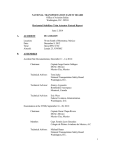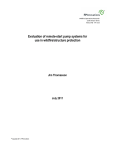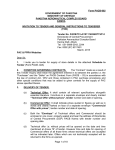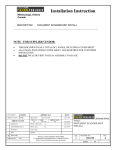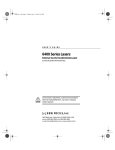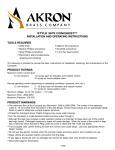Download P12412 User Manual
Transcript
P12412 UV Water Treatment System Safety Mechanism: User Manual Table of Contents: 1. Introduction…………………….…………………………….……….…….…………2 1.1 Background………. ....…...…...………………………………..……….………2 1.2 Acknowledgements ....…...…...………………………………..……….….......2 2. PCB Construction…………………………………………...…...….…….…………3 2.1 Electrical Components……….…..…………………………….…….…………3 2.2 PCB Assembly Instructions..…..……………………………………………….4 3. Valve Construction…………………………………………………….…………..10 3.1 Valve Components………...…………………………………………….........10 3.2 Valve Component Testing…...…………….…………………………………11 3.3 Valve Assembly Instructions…..……………………………………………..11 4. Total System Integration….……………………………………………….……….....…13 5. Troubleshooting…..……..……………………………………………..………......17 5.1 PCB Troubleshooting……....……………………………………….…….......17 5.2 Valve Troubleshooting……...…………….………………………….…..……18 User Manual ver 3.0 Revision 5-21-12 P12412 1. Introduction: 1.1 Background The purpose of this project is to create a safety mechanism for a UV water treatment system in Mexico. The safety system is equipped with photo-diodes inside the UV chambers the measure the amount of UV light being created. Once the UV output falls below a safe value the PCB will cut power to the irrigation valves (which closes them), while simultaneously initiating a warn operating system consisting of LEDs and sirens. For the operators convince during long power outages the PCB is equipped with switches to deactivate the sirens until the supply of power returns. Also to prevent any accidental water contamination there are ball valves located before the irrigation valves for manual shutoffs of the fluid system. These valves will be opened when the bulbs are able to sterilize the water. The following sections will explain all the electrical components and the process to construct the PCB. Also there will be instruction on how to integrate the photo-diodes and the valve system into the UV water treatment kiosk system. The last sections list common problems and troubleshooting technics for the operator. 1.2 Acknowledgements Client: Foundation: MSD Guide: MSD Team: Fermin Reyegadas Fundacion Cantaro Azul Sarah Brownell Matt Switzer Phil Floroff Evan Hall Tyler Josselyn Page 2 of 18 User Manual ver 3.0 Revision 5-21-12 P12412 2. PCB Construction: 2.1 Electrical Components Electrical Component Number (EC #) # of units (per board) Electrical Component Name Description/Comments Figure # 1 1 Speaker Operator warning speaker 2.2.1, 2.2.2 2 3 LED Amber (1), Red (1), Green (1), LEDs for various operator messages 2.2.3 3 1 Switch Operator warning switch 2.2.4 4 1 Power Connector Connector for external power supply 2.2.5 5 1 Battery Connector Connector for 9V battery 2.2.6 6 1 Photodiode UV sensitive photodiode 2.2.7 7 1 Solenoid Solenoid valve connection to board 2.2.8 Page 3 of 18 User Manual ver 3.0 Revision 5-21-12 P12412 2.2 PCB Assembly Instructions Figure 2.2.1: Polarity of Speaker Figure 2.2.2: Leads Connected to Speaker Page 4 of 18 User Manual ver 3.0 Revision 5-21-12 P12412 Connecting Speakers: Refer to Figure 2.2.1-2.2.3 to see proper connection of speakers to circuit board. Use wire length of about 5 inches (or about 13 cm). Solder a wire to both of the connections on the speaker (shown in Figure 2.2.2). When both wires are connected to the speaker, it must then be connected to the proper spot on the circuit board (labeled LS1 on the circuit board). Mind the positive and negative terminals of the speaker and make sure that they are connected properly on the board. The square terminal on the circuit board corresponds to the positive terminal on the speaker. The circular terminal is negative. Figure 2.2.3: LED Polarity and Leads Connected Connecting LEDs: LEDs are connected similarly to the speakers. Figure 2.2.3 shows the polarity of on LED (the positive lead is the longer one). Solder a wire to each lead of the LED, and as with the speakers, solder to the LED slots on the circuit board (labeled LED1, LED2, and LED3). As with the speaker, the square terminal corresponds to positive, the circular terminal negative. LED colors are corresponding slots are listed below: LED1 = Amber/Orange LED, used for low battery indicator LED2 = Red LED, used to warn operator of failure LED3 = Green LED, used to indicate that the failure has been resolved Page 5 of 18 User Manual ver 3.0 Revision 5-21-12 P12412 Figure 2.2.4: Switch with Wires Connected Connecting Switches: Connecting the switch is similar to connecting the LED or Speaker. On the switch, there are holes on the leads where the wires are to be connected. Refer to Figure 2.2.6 to see which leads on the switch to connect the wires to. These correspond to the slots marked 1, 2, 5 and 6 on the SW1 spot on the circuit board. Solder the wires into these slots as shown in Figure 2.2.7. Page 6 of 18 User Manual ver 3.0 Revision 5-21-12 P12412 Figure 2.2.5: Power Supply Connector On-Board Connecting Power Supply Connector: Connect the power supply connector similarly to the previous instructions. The positive and negative terminals on the connector are shown in Figure 2.2.5. As with the previous connections, the square terminal on the board is positive, the circular is negative. Solder the wires through the holes on the terminals on the connector, then solder the wires into the circuit board. Page 7 of 18 User Manual ver 3.0 Revision 5-21-12 P12412 Figure 2.2.6: 9V Battery Connection on Board Battery Connector: The 9V battery connector on the circuit board is shown above in Figure 2.2.6. With this part, the red wire on is positive, the black negative. The circuit board is labeled appropriately in this case as well, with the positive terminal labeled with a (+). Solder the wires through the holes as before with the switch, LEDs, etc. Page 8 of 18 User Manual ver 3.0 Revision 5-21-12 P12412 Figure 2.2.7: Photodiode Connection on Board Photodiode Connection: Figure 2.2.7 shows the connection of the photodiode to the circuit board. For this, only one lead is used, which is the positive lead of the photodiode. Solder the wire from the photodiode into the square terminal with the designation of PD1 on the board. Connection of wires to the photodiode is demonstrated in section 4 of this document, “Total System Integration.” Figure 2.2.8: Solenoid PCB Connection Solenoid Connection: Figure 2.2.8 shows the solenoid valve connection to the circuit board. The solenoid valve connection on the board is designated as P2. In this case, the two leads can be connected to either terminal on the board. Solder the wires as done previously. Page 9 of 18 User Manual ver 3.0 Revision 5-21-12 P12412 3. Valve Construction: 3.1 Valve Components Valve Part Number (VP #) # of units Valve Part Name Description/Comments Figure # 1 2 Ball Vale ½ inch PVC Ball Valve Figure 3.1.1 2 2 Irrigation Valve Electro-Mechanical Safety Valve, The interface between the PCB and the water flow system Figure 3.1.2 Important Parts of the Irrigation Valve 3 2 Solenoid Electric Magnet, controlled by PCB Figure 3.1.3 4 2 Solenoid Piston Opens when power is supplied, Spring loaded to close when power is cut Figure 3.1.3 5 2 Valve Head 6 2 Diaphragm Spring Top of valve, remove bolts to access the valve internals Applies sufficient additional pressure to close valve 5 2 Diaphragm Valve seal Figure 3.1.3 6 2 Valve Block Bottom of valve, fixed to water flow system Figure 3.1.3 Figure 3.1.3 Figure 3.1.3 Page 10 of 18 User Manual ver 3.0 Revision 5-21-12 P12412 3.2 Valve Component Testing VP # Description of how to test valve parts Spec Units Nominal Value 1 Rotate handle clockwise to close, (Handle is perpendicular to pipe flow); Rotate handle counterclockwise to open, (Handle is parallel to pipe flow) NA Handle Rotates 2 Test the manual open leaver, Same orientation as VP 1 NA Leaver Rotates Actual Value Important Parts of the Irrigation Valve 3 Apply 12v power supply to see if magnet activates NA 4 After power is supplied to piston retracts, power is cut piston spring ejects piston NA 5 Bolts can be removed NA 6 Spring can be compressed NA 7 Diaphragm is flexible NA 8 Can sufficiently connected to pipe system, without leaks NA Electrical Field is Created Piston Moves Head detaches Spring flexes Diaphragm fits inside valve No leaks 3.3 Valve Assembly Instructions 1. Each UV chamber will get its own valve system. a. Each system consists of an irrigation valve and a ball valve 2. The irrigation valves should be pre-assembled by the manufacture prior to installer receiving them. 3. The ball valves can be found at any local distributer or hardware store in the plumbing section. 4. The ball valve is located at the irrigation valve inlet. a. The proper orientation of the irrigation valve is given by flow directional arrows located on the connection points for the valve, see Figure 3.3.1. 5. The two valves can be connected in a number of ways with various pipe fittings. a. The important thing that the installer should remember is to use the least number of fittings that will allow the two valves to be located as close as possible. i. Least number of fittings is to reduce cost and potential leakage points. ii. The close proximity to the irrigation valve is to reduce the volume of contaminated water between the valve and the UV chamber. Page 11 of 18 User Manual ver 3.0 Revision 5-21-12 P12412 Figure 3.3.1 Most kiosks will consist of multiple UV chambers. Figure 3.3.2, illustrates how two chambers can be piped together. The inlet is on the left, it is from the contaminated water reservoir on the roof of the kiosk. The water is piped down to a “Tee” pipe fitting. Each side of the “Tee” pipe fitting will lead to a valve system. The valve system has, in series, a ball valve followed by an irrigation valve. Once the water exits the valve system it then ascends to the two UV chambers, which are located to the right, outlet side, of Figure 3.3.2. If additional UV chambers are to be installed inside a kiosk; a separate valve system will be required in series for each chamber. Figure 3.3.2 Page 12 of 18 User Manual ver 3.0 Revision 5-21-12 P12412 4. Total System Integration: At this point the PCB and the Valve System should be assembled and now they should be integrated in to existing and new UV water treatment systems. 1. The first part that needs to be assimilated into the existing design is the valve system. 2. The valve system should be located at the inlet of each UV chamber. 3. Figure 4.1 illustrates the current technique used to pipe the contaminated water supply into the UV chambers. a. There is a single “T” pipe fitting that splits the water flow and directs it to each chamber. b. To integrate the valve systems into the UV water treatment system, this “T” should be moved farther back with respect to the flow of water. c. The overall integration should consist of the water separating “T”, followed by the valve systems then direct connections to their respective UV chambers. i. The valve systems should be connected as close as possible and with the least number of fittings. 1. This will reduce cost and potential leakage points. 2. Also the volume of water, in the pipe, between the valve system and the UV chamber will flow into the chamber even after a failure has occurred. Therefore this volume should be minimized. a. The water that is drained will displace the already sterilized water near the exit of the chamber. d. If there are additional UV chambers required in the kiosk, then this process should be repeated for each chamber. e. When the valve systems are installed they should be installed in an orientation that allows for easy operator access. i. The easy access should allow access to the solenoid’s wires and removal of the solenoid and head from the block of the irrigation valve. ii. This allows any valve maintenance that could be necessary to repair the valve system. 4. The next part of the safety system that should be installed is the PCB and all associative subassemblies. 5. The electrical housing is a junction box; see Figure 4.2: left side, which should be located at any local hardware store. 6. The PCB should be set inside the junction box. Page 13 of 18 User Manual ver 3.0 Revision 5-21-12 P12412 a. Marks should be made on the inside of the box for all of the operator interfaces. i. This includes the LEDs, switches, speakers, wire leads and power connections. b. Then the PCB should be removed to allow for the proper holes to be drilled. i. The proper hole diameters to be drilled will allow the respective operator interface object to fit into it, but not too large to allow foreign agents to enter the box, such as bugs or excess moisture. c. Once the holes are drilled, the PCB should be reinstalled followed by installation of all the operator interface components, see Figure 4.2: right side. i. Electrical tape should be placed along the bottom surface of the PCB, covering the leads which go through the board. ii. If the operator interface components loosely fit inside the housing holes then electrical tape or cocking should be used to secure them in place. iii. The PCB should then be taped and secured to the bottom of the junction box. d. The 9 volt battery should now be connected to its connector e. Flip the switch so that the red LED is ON and the speaker is sounding. This means that the alarm system is working. If this does not happen with the switch in either position, check the troubleshooting portion of this document. f. The top of the housing should be attached to the junction box. 7. The junction box should now be mounted somewhere in the kiosk that allows for easy operator access and maximizes operators awareness. a. This will allow the operator to have full access to the control board. b. The position should be in a location that will grasp the attention of the operator(s) as long as they are either inside or outside, but still close proximity, to the kiosk. 8. At this point the photo-diode should be installed in all of the UV chambers. 9. The photo-diodes should be connected to wire leads by the use of inline crimps, see Figure 4.3. The positive lead of the photodiode is the lead which is on the same side as the tab (which can be seen in Figure 4.3 below). Page 14 of 18 User Manual ver 3.0 Revision 5-21-12 P12412 a. Holes should be made inside the UV chambers about in the center of the germicidal bulb location. b. To allow clearance between the bulb and the photo-diode the actual hole should be located slightly to the side of the bulb, see Figure 4.4, illustrates the location of the UV bulb inside the chamber and the photo-diode position. i. This will allow the photo-diode to have better exposure to the germicidal bulb. c. The inline crimps, see Figure 4.3: Blue Crimps, should be secured to the stainless steel siding of the UV chamber through the use of a single piece of duct tape. i. This will prevent the photo-diode from being dislodged form the chamber while proper positioning is done. 1. The photo-diode should be directed directly at the germicidal bulb. ii. Once the correct orientation is found more duct tape should be applied to the inline crimps to solidify the location. d. The chambers should be reassembled and reinstalled in the kiosks. 10. At this point all proper wire leads should be connected, see Figure 4.5. a. The connection include the PCB to the irrigation valve solenoid and the PCB to the photo-diode b. The wires should be connected using disconnects that are either crimped on or wire nuts will work too. Either way all wire connects should be sufficiently wrapped in electrical tape for operator safety. 11. The system should then be tested to make sure there is full functionality in the safety system a. Make sure the UV light is on. If on, the green LED should be ON, meaning that the system is working and the valve is open, allowing water to flow. Check that water is flowing. b. Flip the switch to the other position, the green LED should be OFF. c. Shut off the UV light source. The speaker should sound and red LED should turn on. Check that the water flow has been cut-off. If so, the system is up and running correctly. Page 15 of 18 User Manual ver 3.0 Revision 5-21-12 P12412 Operator Alert System Functionality: There is an alarm/alert system as previously mentioned used to warn the operator that there has been a failure and water flow has been cut-off. The alarm/alert system consists of a red LED and high pitched speaker. When a failure occurs, the red LED turns ON and the speaker will sound. When the operator hears or sees this alert, they can then flip the switch. This will shut off the speaker and LED. In order to alert the operator that the system is running again, a green LED will turn on. The switch should then be flipped back to its original position so that the speaker and red LED will operate as before when a failure occurs, see Figure 4.7. To insure that there is no contamination during a failure the operator should close the ball valve located in the valve system as soon as they see the red LED and/or hear the siren. This is a manual interface that will ensure that the water cannot flow through the system. At this point the operator can deactivate the siren and red LED via the switch. At the time the operator sees the green LED they should beginning timing. The timing should be anywhere from 5 to 10 minutes depending on the specified bulb warming up time that is instructed with these bulbs. As long as the green LED stays illuminated during this time the operator can reactivate the warn operator system by moving the switch to the previous location. As long as the warn operator system trigger it is safe for the operator to reopen the ball valve in the valve system. Whenever the warn operator system is triggered the ball valve should remain closed. Also as part of nightly shutdown the ball valve should be closed to prevent any contamination. The ball valve closed orientation can be seen in Figure 4.6 Page 16 of 18 User Manual ver 3.0 Revision 5-21-12 P12412 5. Troubleshooting: 5.1 PCB Troubleshooting # Description of Problem Description of Solution Actual Value Step 1) Verify connection of speaker and LED on circuit board 1 Speaker and red LED not operating 2 Green LED fails to illuminate Step 2) Check the polarity of the connections (remember square terminal is positive and on all LEDs the longer lead is positive) NOTE: If polarity is wrong, remember current position and flip part around Step 3) Check the solder connection on the board and on the part. Make sure there is enough solder and adequate connection is made at the part / board interface. NOTE: If there is not enough solder, add more solder. Be mindful to not bridge connections on the board or the part. Add enough solder so that you are comfortable that a good connection has been made OVERALL NOTE: Insufficient solder on any interface location could result in overall system failure. Follow the same steps as previous failure Step1) Check connection between solenoid and PCB wire leads. 3 Failed connection between PCB and Solenoid Step 2) Check connection between PCB solenoid wire leads on PCB. Step 3) Check that solenoid is still responsive. NOTE: Connect direct controllable power supply to solenoid, to simulate system activation to see if solenoid response. Step 4) If solenoid fails to respond to sufficient power supply; replace solenoid. Step 1) Check that power supply is plugged into PCB 4 Control PCB fails to respond or activate Step 2) Check that power supply is plugged into outlet and that power cord is connected to transformer brick. Step 3) Check that power is supplied to kiosk Page 17 of 18 User Manual ver 3.0 Revision 5-21-12 P12412 5.2 Valve Troubleshooting # Description of Problem Description of Solution Actual Value 1 Leakage between valve and pipe connection Apply “Teflon Tape” or other similar sealant to fittings and sufficiently tighten 2 Leakage between head and block Step 1) Align diaphragm properly: there is a small notch in the block that a key on the diaphragm fits into Step 2) Tighten the four bolts that secure the head to the block Step 1) Remove the four bolts and the valve head Step 2) Clean diaphragm with clean water and rag 3 Valve fails to seal Step 3) Flush system with water by opening manual valve, (Make sure and activate UV chamber first or manually close system between irrigation valve and UV chamber to prevent contamination of clean water) Step 4) Re-assemble valve 4 Solenoid leaks Make sure solenoid is inserted correctly and tighten Step 1) Close manual ball valve Step 2) Remove the four bolts and the valve head 5 Upper reservoir empties when valve should be closed Step 3) Clean diaphragm with clean water and rag Step 4) Flush system with water by opening manual valve, (Make sure and activate UV chamber first or manually close system between irrigation valve and UV chamber to prevent contamination of clean water) Step 5) Re-assemble valve 6 Ball valve will not close 7 Solenoid fails to activate Replace ball valve Step 1) Check wire connects between solenoid and PCB Step 2) If that doesn’t work, replace solenoid Page 18 of 18




















